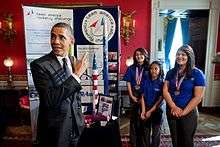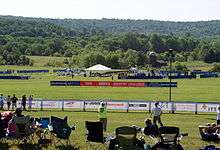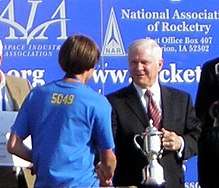Team America Rocketry Challenge
The Team America Rocketry Challenge (TARC) is an annual American model rocketry competition for students in grades six to 12 sponsored by the Aerospace Industries Association and the National Association of Rocketry.[1] Co-sponsors include NASA, United States Department of Defense, the American Association of Physics Teachers and the Civil Air Patrol.[2]


The event receives local and national media coverage and usually draws well-known representatives of the Defense Department, NASA, the FAA, and other government agencies. Past National Fly-Offs have been attended by United States Secretary of Defense Robert Gates, Apollo 11 astronaut Buzz Aldrin, Rocket Boys author Homer Hickam, former NASA Administrator Sean O'Keefe, U.S. Senator Mike Enzi, and former NASA Administrator, Charles Bolden.[3]
The 2010, 2011, 2013, 2015, and 2016 International Fly-Offs were won by the American winners of TARC.[4][5][6]
History
The competition began in 2002 in celebration of the 100th anniversary of flight, but due to a high level of interest became an annual occurrence.[7] TARC fosters interest in aerospace engineering careers among its participants, and the National Fly-Off in May is an opportunity for corporations, universities, and the armed services to attract students.
Requirements
The requirements for each year's challenge are announced during the summer. Teams generally meet early in the school year, and must make official qualifying flights by early April. A team only has three chances to fly an official qualification attempt; only scores from flights that meet the contest requirements, are safe, and don't break the egg(s) can be submitted. Typically, about 60 percent of participating teams submit at least one qualification score. The teams with the top 100 qualifying scores submitted in April compete in the National Fly-off that is held during May at Great Meadow in The Plains, Virginia.
TARC challenges students to design, build and launch rockets that can safely carry one, two, or three raw hen eggs (depending on the year's challenge) and consistently come very close to a specified flight altitude and duration. Success requires excellent design, workmanship, and altitude prediction, which means students can learn about engineering, aerodynamics, meteorology, and computer simulation through the program. Scores are calculated as deductions from the perfect flight; the lower the score, the better. The sum of the difference between altitude and the target altitude and four times the difference between duration and the target duration. Many teams consistently achieve scores less than 10.[8]
Awards to winning teams

The top 10 teams receive a share of $100,000 in scholarships and prizes, and the top 25 teams are invited to submit a proposal for one of 15 spots in NASA's Student Launch Initiative. There are additional awards sponsored by AIA member corporations in various categories.
Starting in 2008, the winners of the U.S. competition have been awarded a trip to either the Paris Air Show or the Farnborough Airshow, courtesy of Raytheon Company, to compete with the winners from other participating countries. The United Kingdom and France currently have similar competitions and compete in the international fly-offs; organizations from Germany, Canada and Japan are in the initial planning stages for starting their own competition. [9]
Awards to the TARC program
The TARC program has picked up the following awards:
In 2013, Marion C. Blakey, President and CEO of the Aerospace Industries Association, and Susan Lavrakas, AIA’s Director of Workforce, received Aviation Week & Space Technology’s Laureate Award in the workforce category for the association’s outstanding STEM education activities, including the Team America Rocketry Challenge. [10][11]
In 2014, the National Aeronautic Association named AIA and the National Association of Rocketry (NAR) the 2014 recipients of the Frank G. Brewer Trophy. The award serves to recognize an “…individual, a group of individuals, or an organization for significant contributions of enduring value to aerospace education in the United States.”[12][13]
In 2015, the National Coalition for Aviation and Space Education (NCASE) selected the Aerospace Industries Association and the National Association of Rocketry to receive its Dr. Mervin K. Strickler Aerospace Education Award, in recognition of their outstanding achievements in the field of aerospace education.[14]
National Flyoff Results
| Contest Year | Launch date | Egg Count | Height Goal | Time Goal | Other Contest Parameters | Contest Winner | Winning Score | Special Guests | Notes |
|---|---|---|---|---|---|---|---|---|---|
| 2002-03 | May 10, 2003 | 2 | 1,500 ft (460 m) | - | Rocket must have two stages. | Boonsboro High School, Boonsboro, MD | 0 | U.S. Senator Mike Enzi, Rocket Boys author Homer Hickam, NASA Administrator Sean O'Keefe | First annual TARC contest. 275 of 873 teams submitted qualifying scores.[3] |
| 2003-04 | May 15, 2004 | 2 | 1,250 ft (380 m) | - | Rocket must have two stages. | Penn Manor High School, Millersville, PA | 0 | U.S. Senator Mike Enzi, U.S. Astronauts Jay Apt and Charlie Walker, Estes Founder Vern Estes | 201 of 610 teams submitted qualifying scores. Flyover by two USMC F/A-18s[7] |
| 2004-05 | May 22, 2005 | 1 or 2 | - | 60 s | 1 or 2 stages; bonus for more complex designs | Dakota County 4-H Federation, Farmington, MN | 0.1 | U.S. Astronaut Jay Apt, NASA Associate Administrator Adeena Loston | 271 of 712 teams qualified. Full scale Goddard rocket launch, USMC Presidential Helicopter Squadron flyover[15] |
| 2005-06 | May 20, 2006 | 1 | 800 ft (240 m) | 45 s | - | Statesville Christian School, Statesville, NC | 1.79 | Apollo 11 astronaut Buzz Aldrin, Mars Exploration Rover Scientist Curt Niebur, Director of Defense Research and Engineering John Young, and NASA Associate Administrator Rex Geveden | 393 of 678 teams qualified. Nationals qualifying score was 21.15. Flyover by 2 USMC AV-8B Harriers[2] |
| 2006-07 | May 19, 2007 | 1 | 850 ft (260 m) | 45 s | - | Newark Memorial High School, Newark, CA | 1.86 | Secretary of Defense Robert Gates, Apollo 11 astronaut Buzz Aldrin, and Astronaut Jay Apt | 301 of 691 teams submitted qualifying scores. Nationals qualifying score was 19.25. F-117 Nighthawk flyover.[16] |
| 2007-08 | May 17, 2008 | 2 | 750 ft (230 m) | 45 s | Contest adopts new two round flyoff. Presentation competition introduced. | Enloe High School (Team 2), Raleigh, NC | (Flight 1) 17.64
(Flight 2) 6.3 (Total) 23.94 |
AIA President Marion Blakey, United States Secretary of the Air Force Michael Wynne | 341 of 643 teams submitted qualifying scores. Nationals qualifying score was 22.2. B-2 Spirit flyover.[17] |
| 2008-09 | May 16, 2009 | 1 | 750 ft (230 m) | 45 s | Egg must lay on its side. | Madison West High School (Team 3), Madison, WI | (Flight 1) 11.94
(Flight 2) 8.6 (Total) 20.54 |
AIA President Marion Blakey, United States Secretary of the Air Force Michael B. Donley | 382 of 653 teams submitted qualifying scores. Nationals qualifying score was 17.6. Flyover by T-38s.[9] |
| 2009-10 | May 15, 2010 | 1 | 825 ft (251 m) | 45 s | Streamer recovery for egg. | Penn Manor High School (Team 1), Millersville, PA | (Flight 1) 3
(Flight 2) 23.32 (Total) 26.32 |
United States Secretary of the Air Force Michael B. Donley, Director of Defense Research and Engineering Zachary Lemnios, Textron CEO Scott Donnelly, Duff Goldman of Ace of Cakes. | 335 of 669 teams qualified. Nationals qualifying score was 29.5. Flyover by USAF Heritage Flight: P-51 Mustang, F-16 Falcon, and F-22 Raptor. High Power Rocket with Ace of Cakes payload.[18] |
| 2010-11 | May 15, 2011 | 1 | 750 ft (230 m) | 40-45 s | Portion of Rocket containing egg must return with 15in (38 cm) parachute. | Rockwall-Heath High School (Team 1), Heath, TX | (Flight 1) 14
(Flight 2) 2 (Total) 16 |
AIA President Marion Blakey | 318 of 607 teams submitted qualifying scores. Nationals qualifying score was 15.87. |
| 2011-12 | May 12, 2012 | 2 | 800 ft (240 m) | 43-47 s | Rockets limited to 650 grams total liftoff weight; motors limited to 80 N·s. | Madison West High School (Team 1), Madison, WI | (Flight 1) 10
(Flight 2) 2 (Total) 12 |
AIA President Marion Blakey, FAA Associate Administrator for Aviation Safety Margaret Gilligan, Assistant Secretary of Defense for Research and Engineering Zachary J. Lemnios, Kaman Corporation Chairman, President & Chief Executive Officer Neal J. Keating. | 409 of 678 teams submitted qualifying scores. Nationals qualifying score was 13.2.[19] |
| 2012-13 | May 11, 2013 | 1 | 750 ft (230 m) | 48-50 s | Portion of Rocket containing egg must return with 15in (38 cm) parachute. Rockets limited to 650 grams total liftoff weight; motors limited to 80 N·s. Egg must lay on its side. External diameter of rocket must be no less than 60 mm.[20] | Georgetown 4H, Georgetown, TX | (Flight 1) 5.36
(Flight 2) 23.88 (Total) 29.24 |
AIA President Marion Blakey, NASA Administrator Charles Bolden | 470 of 735 teams submitted qualifying scores. Nationals qualifying score was 16.12. |
| 2013-14 | May 10, 2014 | 2 | 825 ft (251 m) | 48-50 s | Rockets limited to 650 grams total liftoff weight; motors limited to 80 N·s. Rocket must descend with all pieces tethered to two parachutes of the same size. Best two of three scores summed to determine Finals qualifiers. | Creekview High School (Team 1), Canton, GA | (Flight 1) 6
(Flight 2) 8.88 (Total) 14.88 |
AIA President Marion Blakey, Chief Scientist of the United States Air Force Dr. Mica Endsley | 413 of 707 teams submitted qualifying scores. Nationals qualifying score was 54.12. |
| 2014-15 | May 9, 2015 | 1 | 800 ft (240 m) | 46-48 s | Rockets limited to 650 grams total liftoff weight; motors limited to 80 N·s; rocket length at least 650 mm. Payload must descend separately with a single parachute. Second flight altitude goal at finals is 775 ft (236 m). Best two of three scores summed to determine Finals qualifiers. | Russellville City School, Russellville, AL | 16.16 | CEO Aurora Flight Sciences John Langford, USAF Major General Martin Whelen, NASA Orion Program Executive Garth Henning, Lockheed Martin Vice President, Space & Missile Defense Programs Eric Thoemmes, Raytheon Vice President U.S. Business Development | There were 1080 qualification flight reports from the 685 teams. Nationals qualifying score was 40 (Sum of two best flights of 3 attempts). |
| 2015-16 | May 14, 2016 | 2 | 850 ft (260 m) | 44-46 s | Rockets limited to 650 grams total liftoff weight; motors limited to 80 N·s; rocket length at least 650 mm. Rocket must descend with all pieces tethered to a single recovery device of the team's choosing. One egg to be carried perpendicular to the body's axis, the other to be parallel. Second flight altitude goal at finals is 825 ft (251 m); the duration goal is 43-45 s. Best two of three scores summed to determine Finals qualifiers. | Odle Middle School, Bellevue WA | 13.64 | ||
| 2016-17 | May 13, 2017 | 1 | 775 ft (236 m) | 41-43 s | Rockets limited to 650 grams total liftoff weight; motors limited to 80 N·s; rocket length at least 650 mm. They must use body tubes of two different diameters for their exterior structure. The smaller-diameter of the two must be used for the lower (motor and fin) end of the rocket and
must not be greater than 42 millimeters One egg to be carried. First flight altitude goal at finals is 775 ft (236 m); the duration goal is 41-43 s. Best two of three scores summed to determine Finals qualifiers. |
Festus High School, Festus MO | 13.84 | Brigadier General B. Chance “Salty” Saltzman, the Director of Future Operations, Deputy Chief of Staff for Operations of the U.S. Air Force, Rick Hunt, VADM (Ret.) Raytheon Vice President U.S. Business Development, Dave Machuga, Director and General Manager of Digital Receiver Technology, and William Van Order, LM Fellow at Lockheed Martin Enterprise Business Services. | 489 of 812 teams submitted qualification flight reports; Nationals qualifying score was 31.17. |
Notes
- Duration errors are multiplied by two and added to altitude errors to get score
- Duration errors are multiplied by three and added to altitude errors to get score
- Duration errors are multiplied by four and added to altitude errors to get score
References
- Aerospace Industries Association. "Contest Background". Archived from the original on 1 August 2008. Retrieved 10 March 2012.
- Barber, Trip (2006). "Team America Rocketry Challenge, 2006". Sport Rocketry. 48 (5): 5–12.
- Barber, Trip (2003). "Team America Rocketry Challenge 2003". Sport Rocketry. 45 (5): 12–23.
- Ebersole, Jenna (July 26, 2010). "U.S. Penn Manor TARC rocket team tops in the world". Lancaster New Era. Retrieved 12 March 2012.
- Aerospace Industries Association. "American Students Win International Rocket Contest Fly-Off". Retrieved 10 March 2012.
- "U.S. Team Wins International Rocketry Competition". AIA-Aerospace. Aerospace Industries Association. 19 June 2015. Retrieved 29 February 2016.
- Barber, Trip (2004). "Team America Rocketry Challenge 2004". Sport Rocketry. 46 (5): 11–19.
- "Team America Rocketry Challenge 2016 Rules" (PDF). Team America Rocketry Challenge. National Association of Rocketry (NAR). 29 May 2015. Retrieved 29 February 2016.
- Barber, Trip (2009). "Team America Rocketry Challenge 2009". Sport Rocketry. 51 (5): 24–34.
- "Aviation Week's Laureate Awards Past Recipients". Aviation Week. Archived from the original on 25 November 2014. Retrieved 13 November 2014.
- "AIA Receives Aviation Week & Space Technology Laureate Award for Workforce Development Activities". AIA. Retrieved 13 November 2014.
- Bosco, Cassandra. "THE AEROSPACE INDUSTRIES ASSOCIATION AND THE NATIONAL ASSOCIATION OF ROCKETRY HONORED WITH BREWER TROPHY FOR AVIATION EDUCATION". National Aeronautic Association. Retrieved 13 November 2014.
- "AIA and NAR recognized for significant STEM contributions". Aerospace Industries Association. AIA. Retrieved 13 November 2014.
- "General Aviation News". December 14, 2015. Retrieved 29 February 2016.
- Barber, Trip (2005). "Team America Rocketry Challenge 2005". Sport Rocketry. 47 (5): 5–13.
- Barber, Trip (2007). "Team America Rocketry Challenge 2007". Sport Rocketry. 49 (5): 5–18.
- Barber, Trip (2008). "Team America Rocketry Challenge 2008". Sport Rocketry. 50 (5): 20–30.
- Barber, Trip (2010). "Team America Rocketry Challenge 2010". Sport Rocketry. 52 (5): 5–15.
- Barber, Trip (6 April 2012). "Top 100 Teams for TARC 2012". Retrieved April 6, 2012.
- Aerospace Industries Association. "Contest rules for 2012". Archived from the original on 26 August 2012. Retrieved 31 August 2012.